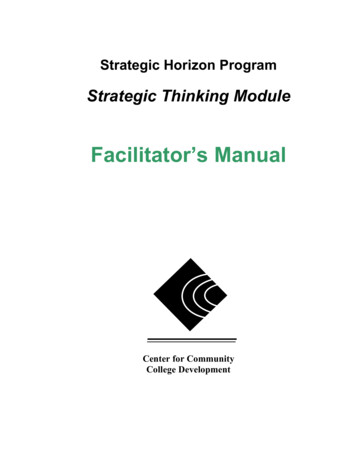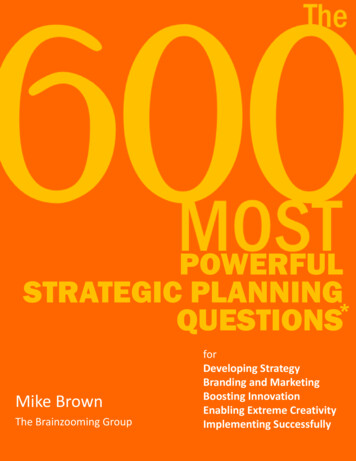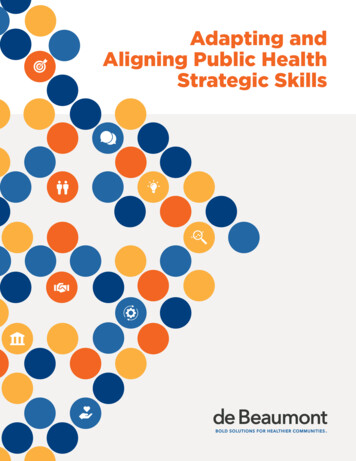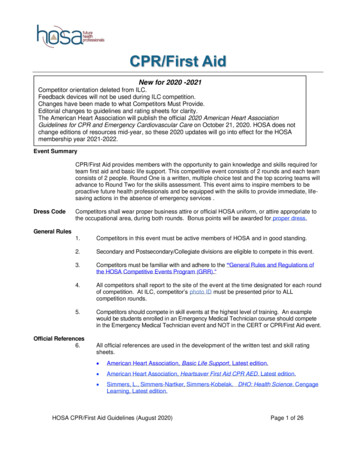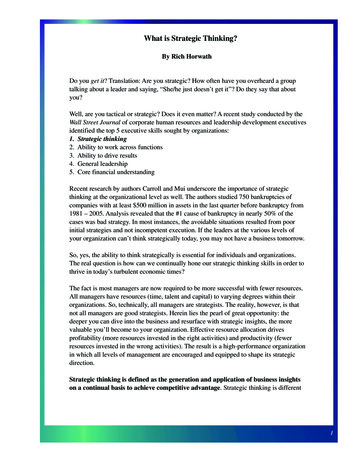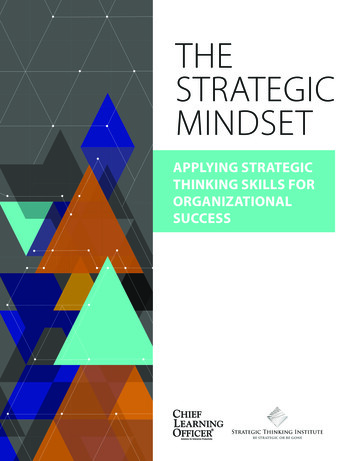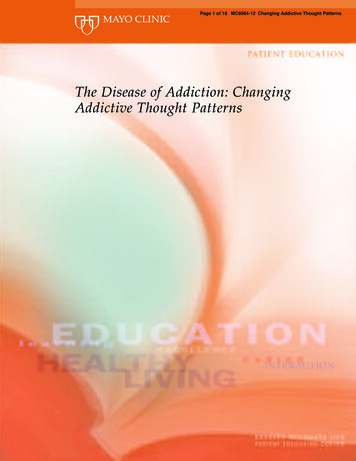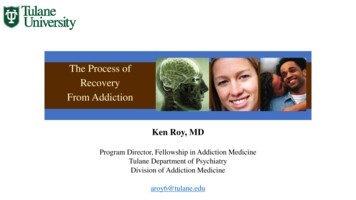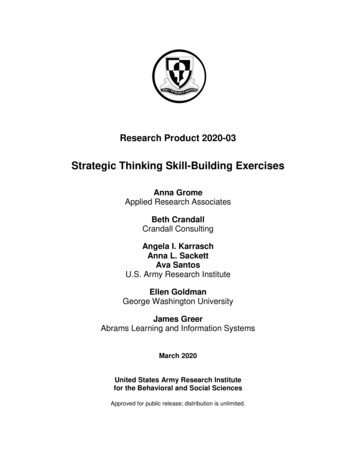
Transcription
Research Product 2020-03Strategic Thinking Skill-Building ExercisesAnna GromeApplied Research AssociatesBeth CrandallCrandall ConsultingAngela I. KarraschAnna L. SackettAva SantosU.S. Army Research InstituteEllen GoldmanGeorge Washington UniversityJames GreerAbrams Learning and Information SystemsMarch 2020United States Army Research Institutefor the Behavioral and Social SciencesApproved for public release; distribution is unlimited.
U.S. Army Research Institutefor the Behavioral and Social SciencesDepartment of the ArmyDeputy Chief of Staff, G1Authorized and approved:MICHELLE ZBYLUT, Ph.D.DirectorResearch accomplished under contractfor the Department of the Army byApplied Research Associates, Inc.Technical Review byWilliam S. Weyhrauch, U.S. Army Research InstituteMelinda J. Key-Roberts, U.S. Army Research InstituteNOTICESDISTRIBUTION: This Research Product has been submitted to the Defense InformationTechnical Center (DTIC). Please address correspondence concerning distribution ofreports to: U.S. Army Research Institute for the Behavioral and Social Sciences, Attn:DAPE-ARI-ZXM, 6000 6th Street Building 1464/Mail Stop: 5610), Fort Belvoir, VA22060-5610.FINAL DISPOSITION: Destroy this Research Product when it is no longer needed. Donot return it to the U.S. Army Research Institute for the Behavioral and Social Sciences.NOTE: The findings in this Research Product are not to be construed as an officialDepartment of the Army position, unless so designated by other authorized documents.
REPORT DOCUMENTATION PAGE1. REPORT DATE (dd-mm-yy)March 20202. REPORT TYPEFinal3. DATES COVERED (from. . . to)October 2016 – December 20174. Title:Strategic Thinking Skill-Building Exercises5a. CONTRACT OR GRANT NUMBERW911NF-14C-00635b. PROGRAM ELEMENT NUMBER6227856. AUTHOR(S)Anna Grome, Beth Crandall, Angela I. Karrasch, Anna L.Sackett, Ava Santos, Ellen Goldman, & James Greer5c. PROJECT NUMBERA7905d. TASK NUMBER4055e. WORK UNIT NUMBER7. PERFORMING ORGANIZATION NAME(S) AND ADDRESSApplied Research Associates U.S. Army Research Institute6000 6th St1750 Commerce Ctr Blvd NFort Belvoir, VA 22060Fairborn, OH 45324-63339. SPONSORING/MONITORING AGENCY NAME(S) ANDADDRESS(ES)U.S. Army Research Institutefor the Behavioral and Social Sciences6000 6th Street, Building 1464Fort Belvoir, Virginia 220608. PERFORMING ORGANIZATION REPORTNUMBER10. MONITOR ACRONYMARI11. MONITOR REPORT NUMBERResearch Product 2020-0312. DISTRIBUTION/AVAILABILITY STATEMENT: Approved for public release: distribution unlimited.13. SUPPLEMENTARY NOTES: ARI Research POC: Dr. Angela Karrasch, angela.i.karrasch.civ@mail.mil14. ABSTRACT (Maximum 200 words):Army leaders who effectively engage in strategic thinking can successfully navigate volatile, uncertain, complex, andambiguous (VUCA) environments. As part of a larger effort to study the impact of practice on strategic thinking development,the U.S. Army Research Institute for the Behavioral and Social Sciences (ARI) developed four practical exercises that will buildand reinforce cognitive and behavioral skills that underpin the ability to think strategically. The four exercises are: Reflecting onthe Environment, Questioning to Deepen Learning, Telling a Story An Exercise in Connecting the Dots, and Envisioning Potential Futures. These exercises can be used in classroom and fieldsettings. This Research Product includes all materials required for each exercise, including a facilitator guide, a slide deck withan overview and brief tutorial, and a participant exercise aid.15. SUBJECT TERMS reflection, questioning, testing, information gathering, synthesis, systems thinking, strategicforesight, thinking in time, learningSECURITY CLASSIFICATION OF16.REPORTUnclassified17.ABSTRACTUnclassified18. THISPAGEUnclassified19. LIMITATIONOF ABSTRACTUnlimitedUnclassifiedi20. NUMBEROF PAGES16021. RESPONSIBLEPERSONDr. Angela Karrasch(913) 684-9758
Research Product 2020-03Strategic Thinking Skill-Building ExercisesAnna Gromeformerly with Applied Research AssociatesBeth CrandallCrandall ConsultingAngela I. KarraschAnna L. SackettAva SantosU.S. Army Research InstituteEllen GoldmanGeorge Washington UniversityJames GreerAbrams Learning and Information SystemsFort Leavenworth Research UnitAngela I. Karrasch, ChiefMarch 2020Approved for public release; distribution is unlimited.ii
ACKNOWLEDGEMENTThe authors would like to thank those who graciously volunteered their time to pilot the exercises andoffer their feedback and suggestions for improving the exercises. The list of individuals includes variousmembers of the University of Foreign Military and Cultural Studies faculty, research psychologists at theU.S. Army Research Institute at Fort Leavenworth, and members of the 1st Infantry Division at Fort Riley,KS. Feedback from these individuals was valuable for improving the exercises to achieve maximallearning benefit for Army leaders. We would also like to thank Dr. Will Weyhrauch, Elena Knyshev andDr. Mathias Simmons for contributions to the research and editing the document.iii
iv
STRATEGIC THINKINGSKILL-BUILDING EXERCISES1
STRATEGIC THINKING SKILL-BUILDING EXERCISESOVERVIEW 3WHY ARE THE SKILL-BUILDING EXERCISES IMPORTANT? . 4REFLECTING ON THE ENVIRONMENT 6QUESTIONING TO DEEPEN LEARNING . 27TELLING A STORY . 66ENVISIONING POTENTIAL FUTURES . 92SUPPLEMENTAL MATERIALS 1282
OVERVIEWThe exercises in this packet address the need to further develop strategic thinking capabilities in theArmy. They are designed to help develop and strengthen the cognitive and behavioral skills needed tobe an effective strategic thinker by providing practice in using those skills.Who Will Benefit from the Exercises?The exercises are intended for use by instructors, unit commanders, and others who wish to providetheir students or staff with instruction and practice in the skills needed for strategic thinking.Participants can range from young lieutenants to experienced NCOs, to field grade officers and above.What Skills Do the Exercises Address?The U.S. Army Research Institute for the Behavioral and Social Sciences (ARI) created a set of practicalexercises that allow students and Soldiers to strengthen skills that will help them develop into effectivestrategic thinkers. These strategic thinking exercises adhere to adult learning principles: problemcentered, offer opportunities for interaction with other learners, have immediate relevance to thelearner’s job, offer opportunities for repetition and deliberate practice, involve feedback to and fromboth peers and facilitators, and provide opportunities for individual and group reflection. A skilledfacilitator can use these exercises in a wide variety of contexts and with leaders from a wide range ofechelons. The exercises focus on four skill areas: reflective thinking, questioning and informationseeking, making connections across disparate information, and anticipating future states.Exercise NamePrimary Skill AddressedReflecting on the EnvironmentReflective thinkingQuestioning to Deepen LearningTelling a Story: An Exercise inConnecting the DotsQuestioning, scanningEnvisioning Potential FuturesSystems thinking, synthesisThinking in time/ strategicforesightSecondary Skills AddressedSystems thinking, hypothesisgenerationSystems thinking, synthesisHypothesis generation, cognitiveflexibility, sensegivingQuestioning, systems thinking,sensegivingMany skills are associated with strategic thinking. The primary and secondary skills above were selectedbecause past research indicated that these skills are needed in the Army, not currently addressed wellenough, related to other critical skills, applicable to multiple echelons, and amenable to development.How Can I Use the Exercises?The exercises are designed to be adaptable for use with a range of participants and in a variety ofcontexts. Each exercise can be used by itself. Exercises can also be combined for a more comprehensivedevelopmental program. Exercises can be used either as stand-alone activities or as part of fieldinstruction or embedded in a course. Three of the exercises, specifically Questioning to Deepen Learning,Telling a Story: An Exercise in Connecting the Dots, and Envisioning Potential Futures, require afacilitator. The exercise Reflecting on the Environment can be implemented with or without a facilitator;thus, this particular exercise can also be used as a self- development activity.3
WHY ARE THE SKILL-BUILDING EXERCISES IMPORTANT?The U.S. Army has recently increased its efforts to enhance the strategic thinking ability of its currentand future leaders. The Army needs leaders who can anticipate change, think long-term, and shape thefuture in a way that aligns with national interests. Research found that many Army personnel feelunprepared for tasks that require strategic thinking. The current effort helps the Army develop highlyeffective strategic thinkers by focusing on foundational skills and experiences that underpin strategicthinking.Before Army leaders can be ready to step into positions that require them to think strategically, theyneed to hone the individual skills and competencies that will allow them to do so. Professionalbasketball players don’t just play a lot of basketball. They practice component skills such as ballhandling, jump shots, rebounding, and footwork. Anyone who plays basketball at advanced levels hasbeen running drills and honing these individual skills for many years. Developing one’s strategic thinkingability is no different. It requires time, practice, and attention to foundational skills.Strategic thinking is required to succeed at the strategic level of war. However, strategic thinking is alsoemployed in other contexts; it can happen at any level, by individuals at any rank, and can be practicedat very early stages in a Soldier’s career. Just as General Officers can think strategically about howcampaigns can be orchestrated to achieve national strategic goals, platoon leaders can thinkstrategically about how their units’ actions can have a ripple effect on the broader mission. At the sametime, although strategic thinking can happen at any level, the types of tasks requiring strategic thinkingskills are likely to expand as individuals advance in rank and responsibility.Strategic Thinking CompetenciesStrategic thinking competencies are needed to successfully engage in the strategic thinking process. Thecompetencies identified by ARI are described below:Comprehensive Strategic thinkers continually scan the environment, seek information fromInformationdisparate sources, suspend judgment and remain open-minded, consider otherGatheringperspectives, and possess listening and research skills.LearningCriticalThinkingStrategic thinkers are lifelong learners who iteratively test, reflect upon,conceptualize, manage knowledge to gain insights on the environment, and examinetheir own thinking.Strategic thinkers identify the essential aspects of a situation, questionassumptions, ask relevant questions, explain meaningful connections anddistinctions, understand nuance, and consider the limits of data.InnovativeThinkingStrategic thinkers generate creative and novel ideas, concepts, andapproaches, independent of conventional norms.Thinking inTimeStrategic thinkers understand historical and contemporary contexts, recognizepatterns, forecast possible futures, and anticipate second- and third-order effects.SystemsThinkingStrategic thinkers use a holistic perspective of the dynamic and complexenvironment to identify interrelationships and integrate disparate factors into acomprehensive whole.4
Strategic Thinking EnablersStrategic thinking enablers help the strategic thinking process (e.g., knowledge of a particular globalregion) but are not essential for the strategic thinking process itself. Each of the strategic thinkingenablers identified by ARI is described in the table RegulationStrategic thinkers draw on a foundation of knowledge that is based on severaldisciplines (e.g., geo- politics, world religions/cultures, economics, technology,sociology) and a specific strategic environment (e.g., local/regional customs,history, stakeholders).Strategic thinkers are aware of their inherent individual limitations and timeconstraints. Consequently, they leverage the capabilities of others in a team orinformal network (e.g., through cooperation, leadership, building trust, conflictmanagement).Strategic thinkers communicate candidly and effectively in multiple media (oral,written, visual) to gain individual understanding. They can tailor their messages topersuade diverse audiences, which is required to implement strategy.Strategic thinkers are intellectually humble and account for their ownnatural limitations and biases related to emotion, perspective, and selfinterest. At the same time, they maintain respect for differing values andpriorities.5
STRATEGIC THINKING SKILL-BUILDING EXERCISEREFLECTING ON THE ENVIRONMENT6
STRATEGIC THINKING SKILL-BUILDING EXERCISEREFLECTING ON THE ENVIRONMENTFACILITATOR EXERCISE GUIDE . 8SAMPLE FACILITATOR SCRIPT . 10OVERVIEW SLIDES . 16TUTORIAL SLIDES . 19PARTICIPANT EXERCISE OVERVIEW AND TIPS 22PARTICIPANT EXERCISE AID . 247
REFLECTING ON THE ENVIRONMENTFACILITATOR EXERCISE GUIDEExercise PurposeThis exercise provides practice in using reflective thinking to enhance learning, and in asking oneself arange of questions to promote deep reflective thinking. Reflective thinking refers to the thinking andjudgments that occur during the process of “stepping back” from a situation to think critically anddeeply about the experience. Thinking critically before, during, and after an event provides anopportunity to develop greater understanding of both the self and the situation and inform futureencounters with similar situations. This exercise also addresses systems thinking and hypothesisgeneration.Estimated Run TimeThis exercise will take approximately 2 to 2-1/4 hours. To reduce the length of the exercise, certainportions of the exercise can be conducted as homework or on one’s own time.Summary of the Exercise Participants reflect on a recent experience that involved an element of surprise or did not turnout the way they expected.Participants are prompted to ask themselves questions that focus on aspects of reflectivepractice, including reflective thinking on content, process, and premise (i.e., what, how, andwhy).Then, participants work with others to describe what they considered, to pose additionalquestions, and to reflect collectively.Learning ObjectivesParticipants will learn to: Appreciate the importance of reflective thinking for continuous learning and strategic thinking. Recognize the value of different types of questions for yielding unique types of information. Demonstrate greater ease in reflecting on an experience. Appreciate reflective thinking as an opportunity to identify connections and inter-relationshipsthat may not otherwise be apparent. Recognize when and how to use iterative reflective thinking in daily operations to supportcontinuous learning and improved strategic thinking.Relation to Other ExercisesThis exercise works well as the first exercise, prior to Questioning to Deepen Learning, Telling a Story,and Envisioning Potential Futures. It is less complex than the other three activities and provides a goodstarting point. It also allows participants to practice and discuss reflective thinking, an activity that isembedded in all of the exercises.8
Materials Needed (Facilitators) This exercise does not require a facilitator; it can be conducted individually. However, it can alsobe conducted with a facilitator and in a group setting.Whiteboard and markersOne Participant Exercise Aid for each participant (provided in this packet)Materials Needed (Participants) Participant Exercise Aid (provided by facilitator)Pen/pencilNotebook or paperFacilitator Tips and Guidance Reassure participants that confusion can be a normal part of the reflective process.Remind participants to reflect on why events occurred as they did, in addition to what and howthings happened.Encourage participants to use different types of reflective questions to achieve progressivelydeeper levels of learning.Encourage participants to engage in reflective thinking on their own or with a mentor or groupof peers.If participants are unable to recall an operational situation: It is acceptable for them to work with a surprising situation from their personal history instead. Although reflecting on an operational situation will provide added value, the most importantpart of the exercise is that participants gain practice in reflecting (on any experience) and usingdifferent types of questions to drive learning.9
REFLECTING ON THE ENVIRONMENTSAMPLE FACILITATOR SCRIPTThe next several pages provide step-by-step instructions for facilitating the exercise, along with some sample facilitator language. The sample languageis intended as only a starting point, particularly for those with limited facilitation experience. Facilitators should adapt the language offered here tomake it their own.Several of the steps in this exercise are noted with the following icon:. This icon denotes activities participants can conduct as homeworkoutside of the classroom, in order to reduce the length of in-class time required for the exercise.If you choose to do all (or most) of the activities within the classroom setting, we have noted natural break points in the exercise that could be used todivide the exercise over multiple sessions. Those are indicated using this icon:Although facilitators should adapt language and adjust the amount of time spent on various activities, we do recommend that facilitators include allthe activities and follow the sequence indicated here in order to achieve the learning objectives.StepSample Language1. EXERCISE SET UPToday we are going to practice our reflective thinking skills.(35-45 minutes)1.1 Distribute and describe theParticipant Exercise AidThis aid contains information that you will use throughout the exercise. I’ll let youknow when you need to turn to a particular section.Also, this aid is something you can take with you after the exercise. It has someinformation in it about the reflective thinking skill we’re practicing in the exercise, whyit is important for strategic thinking, and some tips to help you in applying the skilllater.1.2 Conduct pre-exercise reflectionRefer participants to Pre-ExerciseReflection in their exercise aid.Before we get started with the exercise, I’d like us to take a few minutes to do somethinking. Please flip to the Pre-Exercise Reflection section of your exercise aid.10
StepSample LanguageAsk them to reflect individually onquestions posed.Discuss responses as a group.1.3 Provide brief tutorial to participantsTake a few minutes to think about the questions posed there. Then we will discussthem as a group.[Facilitate discussion around the following questions]1. When are you most likely to engage in reflective thinking? Why?2. How do you engage in reflective thinking?3. Think about times when you engage in reflection. What helps you move into areflective mode?4. Is there a particular person (or more than one person) who helps you thinkreflectively—someone you tend to use as a sounding board? What is it about thatparticular individual?5. How do you expect reflective thinking to help you? What will you gain fromreflective thinking?[See tutorial slides.]Adapt content as needed.11.4 Provide Participant Exercise Overviewand TipsEmphasize the exercise is aboutpracticing skills important forstrategic thinking.As we just discussed in the brief tutorial, the ability to learn from past and currentsituations, and to apply that learning to the decisions you make about futuresituations, is important to becoming an effective strategic thinker.Reflecting upon and learning from past situations is what this exercise is about.Before we move into the exercise itself, I’d like to emphasize that what we’re doingtoday is practicing a skill that is important for strategic thinking. This exercise is notabout learning new concepts. It’s not about making sure you can define reflectivethinking. Rather, it is about practicing a skill – reflective thinking – that is importantfor strategic thinking.This exercise, by itself, is not going to transform you into an expert strategic thinker.Developing the ability to think strategically takes a considerable amount of time,exposure to relevant experiences, a strong conceptual knowledge base, and a lot ofpractice.1The facilitator may choose to give the tutorial verbally, print out the tutorial for participants, project the content in PowerPoint, or some combination thereof.11
StepSample LanguageSo, you may want to think of this exercise as an activity that will help you learn tocrawl, before you can learn to walk, and before you can ultimately learn to run and bea skilled strategic thinker.Provide an analogy.Another way to think about this exercise is akin to what young athletes experience ontheir way to becoming exceptional athletes.A basketball player practices component skills such as dribbling, passing, lay-ups, andshooting free throws. Practicing these component skills – and doing so repeatedly andover time – is essential to becoming a skilled basketball player.In the same way, what we’re doing today is a drill to help you practice the skill ofreflective thinking. Reflective thinking is just one (of many) skills you will need to be apowerful strategic thinker.Also, remember that athletes don’t become great overnight. They have to practiceover and over to develop the skills they need. This is the same with strategic thinking.We need to practice repeatedly the component skills necessary for being a greatstrategic thinker.Describe the activity.To practice the skill of reflective thinking today, I’m going to ask you to identify arecent event or situation that went differently than you expected. Then you willconsider a set of questions to help prompt your thinking about that situation. Thequestions will help you to think in greater depth about what happened, how ithappened, and why it happened.12
Step2. IDENTIFY AND REFLECT ON SITUATION(Individual Activity)(30 minutes)2.1 Ask participants to recall a recentoperational situation or event thatwent differently than expected2This can be an individual situation orevent or one shared by everyone inthe group.Sample LanguageI’d like you to start by thinking about a recent operational situation or event that didnot go as expected.It should be an event you were personally involved in, rather than one you heardabout secondhand.This can be a situation in which the outcome was worse than expected or one wherethings turned out better than expected.The situation should be vivid enough in your memory that you can recall specificdetails.Later in the exercise, you will be describing your event to others. So make sure youselect an event that you will feel comfortable sharing.2.2 Refer participants to StarterQuestions in the exerciseaidPlease take a look at the Starter Questions section in your exercise aid. You will see aset of questions that can help prompt your thinking.2.3 Ask participants to workindependently to reflect on theevent, using the starterquestions in the exercise aidWorking on your own, spend 20-25 minutes thinking about what contributed to thesituation unfolding in the way it did.Use the starter questions provided in the exercise aid to prompt your thinking.Don’t feel limited to these questions. If other ideas occur to you, feel free toexplore them. Be sure to spend time on each type of reflection: The first set of questions will help you reflect on content – the description of whathappened.If participants are unable to recall an operational situation that went differently than expected, it is acceptable for them to work with a surprising situation fromtheir personal history instead.213
StepSample Language The second set of questions will help you reflect on process – the explanation ofhow the event unfolded.The third set of questions will help you think about premise – the consideration ofwhy the event happened and the assumptions you held about the situation.As you reflect on the event and answer the questions, please jot down some notes soyou can share what you thought about with others later in this exercise.3. PARTICIPANTS SHARE REFLECTIONS(Small Group Activity)(25-30 minutes)3.1 Have individuals pair up with one ortwo other peopleNow that you have each spent some time reflecting on your situation or event, I’dlike you to pair up with one or two other people to discuss the event. The discussionwill focus on what each of you considered and learned so far as you’ve reflected onthe situation that went differently than you expected.3.2 Ask each participant to brieflydescribe the situation or event theyexperienced to others in their groupFirst, take turns and describe the situation or event that you reflected on to the otherperson(s) in your small group. You should spend just a few minutes doing this.Participants should do this in 3minutes or less.3.3 Ask each participant to describe theirresponses to the reflection questionsThen, I’d like each of you to describe how you answered the reflection questions aboutthat situation or event. Take the questions one at a time so that each person has achance to share his/her responses. [Plan on spending 10-15 minutes on this portion.]As others present their reflections, ask additional questions of the presenter orprovide comments that build on their interpretation and reflection.Maybe you see a relationship that the presenter hasn’t mentioned, or maybe you havea clarifying question. Your questions should focus on helping the presenter reflectmore deeply on the event and consider additional connections that they may not haveconsidered.14
Step4. EXERCISE DEBRIEF(Group Activity)(25-30 minutes)Sample LanguageWe are now going to spend some time thinking about what we have done and learnedin this exercise.4.1 Refer participants to ExerciseDebrief in the exercise aidPlease turn to the Exercise Debrief section of your exercise aid, and take a look atthe debrief questions.4.2 Ask them to consider each of thequestions and write notes inresponse to themFirst, please take about 5-10 minutes to think through each of these questionsindividually and jot down some notes. After you’ve had a chance to work with thequestions individually, we are going to discuss them as a group.4.3 Facilitate group discussion of thequestionsI’d like to now spend some time discussing each of these questions as a group.[Facilitate discussion of the following questions.]1. How has your understanding of the situation changed? Are there particular aspects of the situation that you now understand moreclearly? What have you learned or become aware of that hadn’t occurred to youbefore? Are there particular points of view that you hadn’t previously considered orappreciated in the same way you do now? Are there alternative actions you hadn’t previously considered that you nowrealize you could have? Are there certain connections and inter-relationships at play in this situationthat you hadn’t previously recognized that you do now? What else have you gained from reflecting on the situation?2. Think about the different types of questions (content, process, and premisequestions) you considered. How might different types of questions contribute todeeper insights?3. Do you see any drawbacks to reflection? That is, can a person be too reflective?4. In what ways do you anticipate using reflective thinking in your daily operations?What might get in the way of reflection? Do you have ideas for how you mightaddress those obstacles?5. Do you think you engage in enough reflective thinking? If not, how might you engage in reflective thinking more often? How might you balance quantity vs. quality of reflection?15
16
17
18
19
20
21
REFLECTING ON THE ENVIRONMENTPARTICIPANT EXERCISE OVERVIEW AND TIPSWhat’s the Purpose of this Exercise?TipsThe purpose of this exercise is to give you practice inreflective thinking. You will spend time reflecting on arecent experience that went differently than expected,answering progressively deeper and more critical typesof questions. Specifically, you will practice: Using reflective thinking to promote continuouslearning. Considering different types of questions toachieve progressively deeper levels of learning. Using reflective thinking to identify connectionsand inter- relationships that may not otherwisebe apparent. Considering when and how you can engage inreflective thinking in daily operations to supportlearning and improve strategic thinking.Why Is This Skillset Important for Strategic Thinking?Reflective thinking promotes progressively deeperinsight into situation dynamics and how your actionsand assumptions influenced what happened. Reflectivethinking supports continuous learning and the transferof that learning to shape future experiences.Brief TutorialReflective thinking is the process of stepping back froma situation to think critically and deeply about theexperience. Reflective thinking allows you to gaingreater insight into the dynamics of a situation and yourrole in it. It enables you to consider connections andinter-relationships that may not be immediatelyapparent.Reflective thin
Many skills are associated with strategic thinking. The primary and secondary skills above were selected because past research indicated that these skills are needed in the Army, not currently addressed well enough, related to other critical skills, applicable to multiple echelons, and amenable to development. .Cited by: 1Publish Year: 2020Author: Anna Grome, Beth Crandall, Angela I. Karrasch, Anna L. Sackett, Ava Sa
